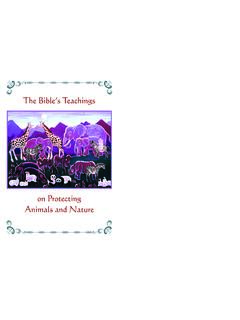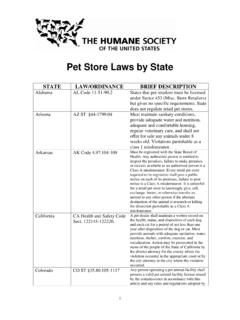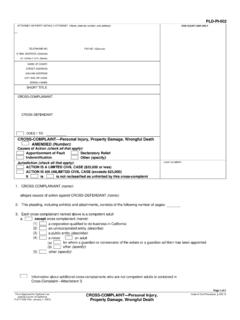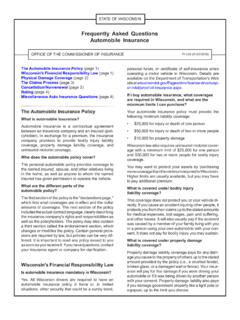Transcription of Recommended Pet Policies - Humane Society of the United …
1 Recommended Pet Policies for Condominiums and Apartment Buildings The provisions noted here may be adopted as is or serve as a guide in developing appropriate rules and regulations for your pets-welcome policy. Most of these provisions also apply to private rental houses and townhouses. A. Screening/Registration Pet caregivers must complete a Pet Application Form before occupying the unit. If the pet is a dog or a cat, a current photograph should be attached. The (resident manager, board of directors, managing agent) will present a copy of the house Policies to the resident for review and signature. B. Permissible Pets Along with determining which species of animals to allow in your building, you should also consider how many pets per resident are reasonable.
2 Because pets often are happier living in pairs, do not summarily restrict residents to only one pet per household. Establish reasonable limits based on the activity level of the pet and the care and exercise provided by the owner. 1. Dogs Number Allowed __ Weight Limit*_____ *Weight limits for dogs should generally be used only for rental units on upper floors of apartment buildings that lack carpeting or other means of effective soundproofing. 2. Cats Number Allowed __ 3. Rabbits Number Allowed __ 4. Birds Number Allowed __ 5. Small Caged Animals (limited to guinea pigs, hamsters, gerbils, ferrets, mice, and rats) Number Allowed __ C. Restrictions 1. Pets shall not be kept, bred, or used for any commercial purpose.
3 All cats, dogs, rabbits, and ferrets must by spayed or neutered by six months of age unless the procedure is deemed medically unsafe by a veterinarian. 2. Pets must be confined to the pet owner s unit and must not be allowed to roam free or be tethered. Pets must not be left unattended on patios or balconies. Pets in transit are to be carried, restrained by a leash, or placed in an animal carrier. Resident dog caregivers in transit may take their pet out of the building only by way of: _____ ( , the lobby, the staircase, parking areas, garage, etc.). Pets shall be exercised in _____ ( , only off the premises of the building, in pet exercise areas specifically designated for their use, etc.). 3. Persons who walk pets are responsible for immediately cleaning up after their animals and discarding securely bagged pet droppings in the following designated areas only: _____.
4 Cat litter may not be disposed of in toilets. No pet waste may be dropped down trash chutes unless securely double-bagged. 4. Pet caregivers shall use designated pet-only washers and dryers (if applicable) to launder pets bedding, toys, blankets, etc. 5. Pet caregivers are responsible for any damage caused by their pets. Any damage caused by cleaning chemicals or other such materials used in an attempt to remedy said damage is also the full responsibility of the pet owner. 6. No pet shall be allowed to become a nuisance or create any unreasonable disturbance. Examples of nuisance behavior for the purposes of this paragraph are: a. Pets whose unruly behavior causes personal injury or property damage .
5 B. Pets who make noise continuously and/or incessantly for a period of 10 minutes or intermittently for _____ hour(s) or more to the disturbance of any person at any time of day or night (check local animal nuisance laws) . c. Pets in common areas who are not under the complete physical control of a responsible human companion and on a hand-held leash of no more than six feet in length or in a pet carrier. d. Pets who relieve themselves on walls or floors of common areas. e. Pets who exhibit aggressive or other dangerous or potentially dangerous behavior. f. Pets who are conspicuously unclean or parasite infested. 7. Notwithstanding any other provision herein, disabled individuals may keep assistance animals in their units.
6 Furthermore, nothing herein shall hinder full access to the apartments and the common areas by individuals with disabilities. 8. Feeding and caring for managed cat colonies is acceptable. Stray or injured cats shall be trapped by the colony caretaker and care provided as necessary. Where no caretaker is available, stray or injured animals shall be reported to the local animal control authority for rescue. 9. Residents are responsible for the pets of guests who visit their unit; such pets are subject to the same restrictions as resident pets. No pet(s) of guests can stay in the unit for more than 14 days (consecutive or staggered) in any one-year period without prior written permission of the resident manager.
7 10. Pet caregivers shall indemnify the association and hold it harmless against loss or liability of any kind arising from their pet(s). D. Enforcement Any resident or managing agent personnel observing an infraction of any of these rules shall discuss the infraction in a neighborly fashion with the pet caregiver in an effort to secure voluntary compliance. If the complaint is not resolved, it must be put in writing, signed, and presented to the (board of directors, managing agent, resident manager, etc.). If the board is in agreement with such complaint, the pet caregiver will receive written notice of the violation. If upon the [insert number] violation(s) the problem is still unresolved, arrangements will be made for a hearing.
8 (At the board s discretion, immediate arrangements for a hearing may be made if the nature of the complaint involves personal injury or the imminent threat thereof.) The board of directors may require the permanent removal of any pet, if such pet is determined by the board to be a nuisance or a danger to the housing community and its residents. If so determined, the pet caregiver will have [insert number] days to remove the pet from the premises. The board of directors also has the authority to assess and collect fines for violations of the house rules pertaining to pets and to assess and collect amounts necessary to repair or replace damaged areas or objects. The Humane Society of the United States recommends a minimum of 30 days.
9 Note: When enacting regulations, an association and/or the association s attorneys should always carefully examine the building s declarations and bylaws to confirm that the proposed rules are consistent with existing documents. Adapted with permission from materials originally produced by the Hawaiian Humane Society . Information from The Humane Society of the United States ( )













